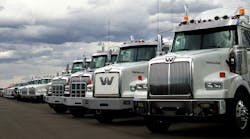Can a highway change the course of history? Yes and no. The national highway system, a.k.a. the Interstate, created under the auspices of the Eisenhower Administration in the 1950s, surely shifted the economic underpinnings of the nation, laying down the footing upon which today's trucking industry is built.
But shifting the course of history? That's a much tougher sell.
Nevertheless, it's a claim that continues to be made about another great roadway — the Alaska Highway. This 1,422-mile behemoth came into being from a mixture of war strategy, panic, and undoubtedly the sheer self-interest of myriad businesspeople and politicians. At a cost of $500 million, more than 16,000 soldiers and 22,000 civilians labored for two years in the midst of WWII to make a “rough cut” road through mountains and forests, over roaring rivers, and in temperatures ranging from 90 deg. F to -70 to create a land link between the continental U.S. and its “exposed” northern flank in Alaska. All this effort was ostensibly to close off a potential invasion route by Japan.
In hindsight, these fears seem overblown. And despite the fact that many consider this “road to nowhere” a waste of time and money, its historical significance should not be overlooked.
Heath Twichell, a retired army officer, has made sure that won't happen. He has written a book titled “Northwest Epic: The Building of the Alaska Highway.” Among other things, he points out that the highway was used “to support a chain of airfields to fly lend lease planes to Russia…probably our most important effort in support of the Russians. Did it defeat the Germans for them? No. Did it help them keep their air force alive so they could continue with their counter-offensives? Certainly. It was one more tool they used to defeat the Nazis.”
The highway also served as one of the many theatres in WWII where African-American soldiers distinguished themselves. “Three of the regiments out of the seven involved in the highway's construction were black soldiers and their hard work played a role in the awakening need for equality in the U.S.,” said Twichell, noting that his father, Maj. Heath Twichell of the 35th engineers, commanded one of those regiments before moving onto Europe.
Twichell's father wrote a 100-page draft of his memoir that included his experience on the Alaska Highway, but poor health prevented him from finishing it. This draft turned out to be the impetus for his son's book. “I had a heart attack in 1978 and had to retire from the Army. It was then that I stumbled on Dad's memoirs,” Twichell told me. “It really grabbed me — this largely untold story of the highway — so I started researching and writing about it from 1981 to 1992.”
It wasn't idle research, either. A graduate of West Point, Twichell served 24 years as an infantry officer and led troops in the U.S., Germany and Vietnam. He taught history at West Point, as well as policy and strategy at the U.S. Naval War College. His biography of General Henry T. Allen won the Allen Nevins Prize for best doctoral dissertation in American history for 1972.
To Twichell, the story of the highway is worth telling, not just because of its role in the war effort or its impact on race relations, but because it helped create a vibrant economic corridor from Alberta through the Yukon and up into Alaska.
“It's not a freight corridor per se — you won't see many trucks on the Alaska highway — but it created a physical link between those Canadian provinces, the continental U.S. and Alaska that never existed before. It may have taken several generations to realize the benefit, but it's there,” said Twichell. “There's no other transportation infrastructure like it.”


